Financial Decision Making Report: Project Appraisal and Costing
VerifiedAdded on 2021/02/19
|7
|1674
|124
Report
AI Summary
This report provides a comprehensive overview of financial decision-making processes. It delves into various project appraisal techniques, such as payback period, net present value (NPV), and internal rate of return (IRR), discussing their advantages and disadvantages. The report further analyzes a lease versus purchase decision, providing a numerical example to determine the optimal time frame for each option. Additionally, it explores the concepts of traditional costing and relevant costing, offering a comparative analysis with a numerical illustration to demonstrate their impact on profit calculation and decision-making. The conclusion emphasizes the importance of evaluating appraisal techniques and considering relevant costs for sound financial decisions.

Financial Decision Making
Paraphrase This Document
Need a fresh take? Get an instant paraphrase of this document with our AI Paraphraser
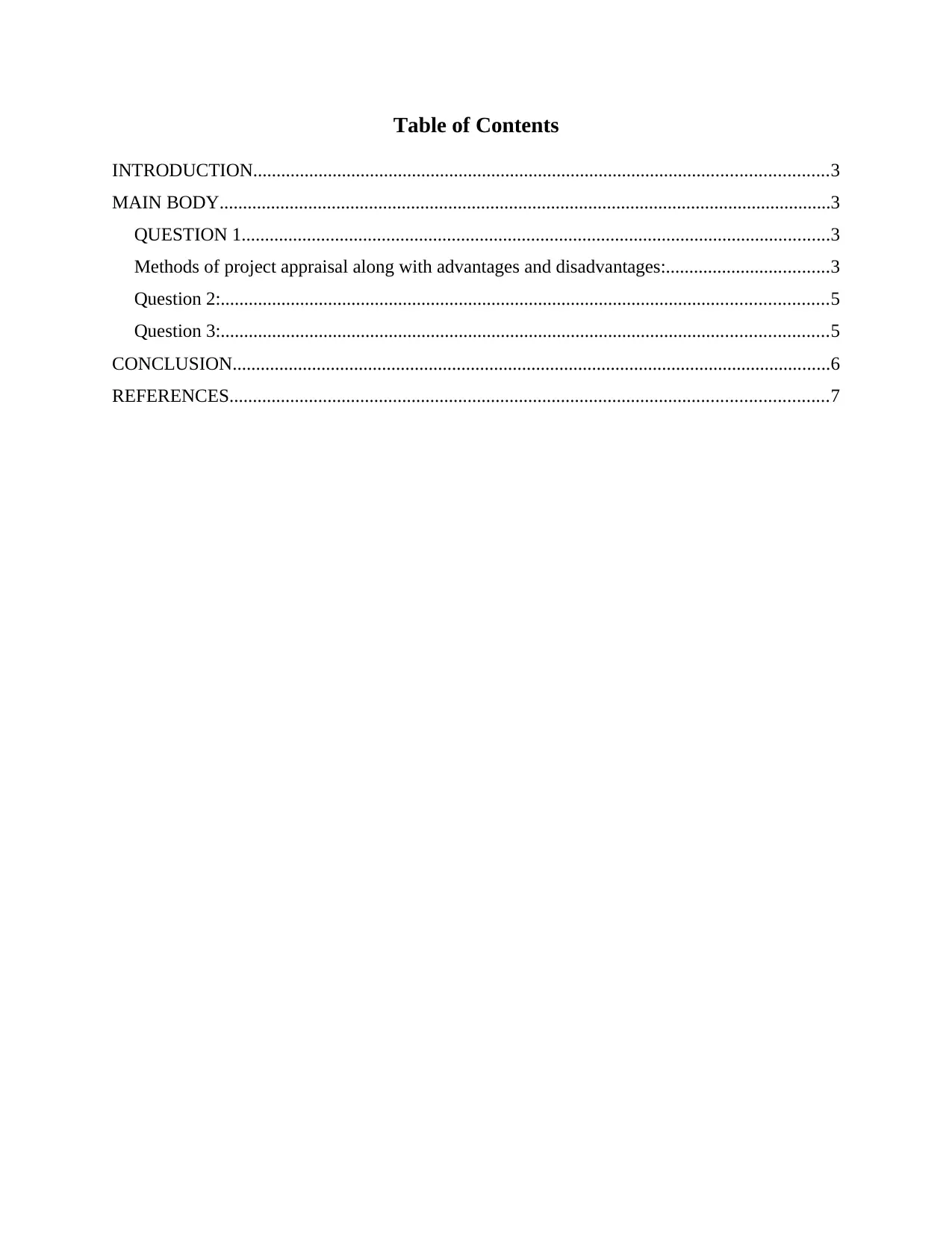
Table of Contents
INTRODUCTION...........................................................................................................................3
MAIN BODY...................................................................................................................................3
QUESTION 1..............................................................................................................................3
Methods of project appraisal along with advantages and disadvantages:...................................3
Question 2:..................................................................................................................................5
Question 3:..................................................................................................................................5
CONCLUSION................................................................................................................................6
REFERENCES................................................................................................................................7
INTRODUCTION...........................................................................................................................3
MAIN BODY...................................................................................................................................3
QUESTION 1..............................................................................................................................3
Methods of project appraisal along with advantages and disadvantages:...................................3
Question 2:..................................................................................................................................5
Question 3:..................................................................................................................................5
CONCLUSION................................................................................................................................6
REFERENCES................................................................................................................................7
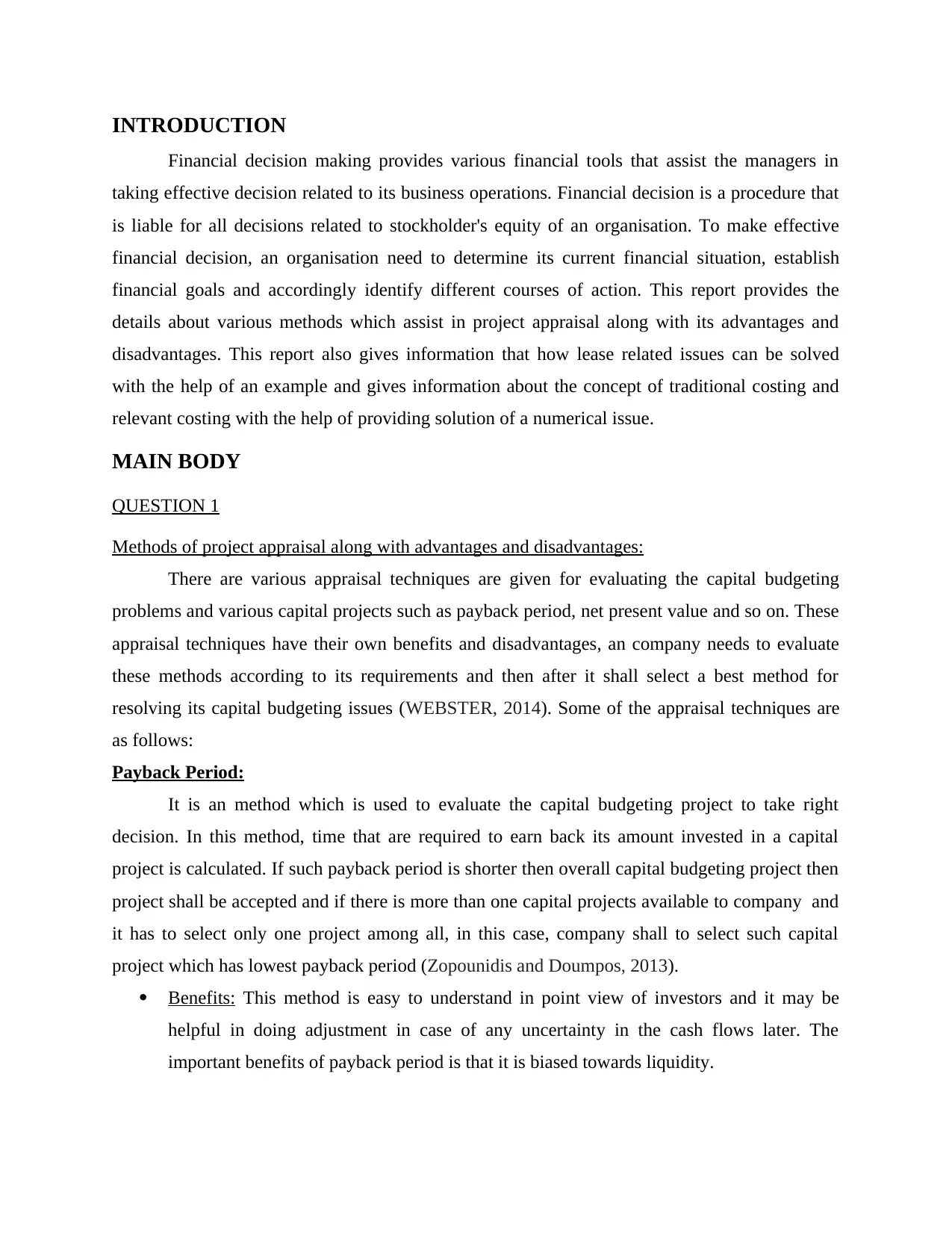
INTRODUCTION
Financial decision making provides various financial tools that assist the managers in
taking effective decision related to its business operations. Financial decision is a procedure that
is liable for all decisions related to stockholder's equity of an organisation. To make effective
financial decision, an organisation need to determine its current financial situation, establish
financial goals and accordingly identify different courses of action. This report provides the
details about various methods which assist in project appraisal along with its advantages and
disadvantages. This report also gives information that how lease related issues can be solved
with the help of an example and gives information about the concept of traditional costing and
relevant costing with the help of providing solution of a numerical issue.
MAIN BODY
QUESTION 1
Methods of project appraisal along with advantages and disadvantages:
There are various appraisal techniques are given for evaluating the capital budgeting
problems and various capital projects such as payback period, net present value and so on. These
appraisal techniques have their own benefits and disadvantages, an company needs to evaluate
these methods according to its requirements and then after it shall select a best method for
resolving its capital budgeting issues (WEBSTER, 2014). Some of the appraisal techniques are
as follows:
Payback Period:
It is an method which is used to evaluate the capital budgeting project to take right
decision. In this method, time that are required to earn back its amount invested in a capital
project is calculated. If such payback period is shorter then overall capital budgeting project then
project shall be accepted and if there is more than one capital projects available to company and
it has to select only one project among all, in this case, company shall to select such capital
project which has lowest payback period (Zopounidis and Doumpos, 2013).
Benefits: This method is easy to understand in point view of investors and it may be
helpful in doing adjustment in case of any uncertainty in the cash flows later. The
important benefits of payback period is that it is biased towards liquidity.
Financial decision making provides various financial tools that assist the managers in
taking effective decision related to its business operations. Financial decision is a procedure that
is liable for all decisions related to stockholder's equity of an organisation. To make effective
financial decision, an organisation need to determine its current financial situation, establish
financial goals and accordingly identify different courses of action. This report provides the
details about various methods which assist in project appraisal along with its advantages and
disadvantages. This report also gives information that how lease related issues can be solved
with the help of an example and gives information about the concept of traditional costing and
relevant costing with the help of providing solution of a numerical issue.
MAIN BODY
QUESTION 1
Methods of project appraisal along with advantages and disadvantages:
There are various appraisal techniques are given for evaluating the capital budgeting
problems and various capital projects such as payback period, net present value and so on. These
appraisal techniques have their own benefits and disadvantages, an company needs to evaluate
these methods according to its requirements and then after it shall select a best method for
resolving its capital budgeting issues (WEBSTER, 2014). Some of the appraisal techniques are
as follows:
Payback Period:
It is an method which is used to evaluate the capital budgeting project to take right
decision. In this method, time that are required to earn back its amount invested in a capital
project is calculated. If such payback period is shorter then overall capital budgeting project then
project shall be accepted and if there is more than one capital projects available to company and
it has to select only one project among all, in this case, company shall to select such capital
project which has lowest payback period (Zopounidis and Doumpos, 2013).
Benefits: This method is easy to understand in point view of investors and it may be
helpful in doing adjustment in case of any uncertainty in the cash flows later. The
important benefits of payback period is that it is biased towards liquidity.
⊘ This is a preview!⊘
Do you want full access?
Subscribe today to unlock all pages.

Trusted by 1+ million students worldwide
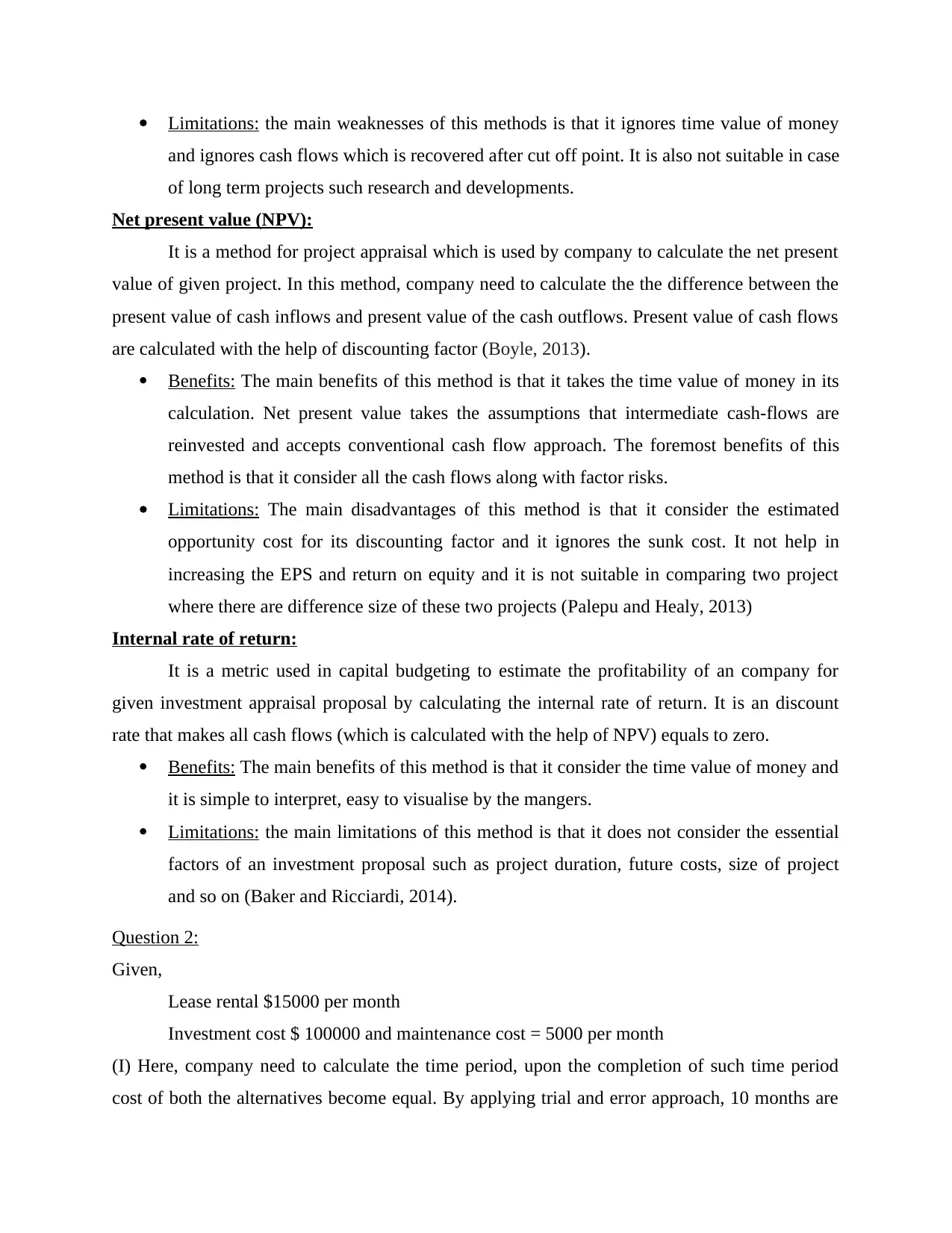
Limitations: the main weaknesses of this methods is that it ignores time value of money
and ignores cash flows which is recovered after cut off point. It is also not suitable in case
of long term projects such research and developments.
Net present value (NPV):
It is a method for project appraisal which is used by company to calculate the net present
value of given project. In this method, company need to calculate the the difference between the
present value of cash inflows and present value of the cash outflows. Present value of cash flows
are calculated with the help of discounting factor (Boyle, 2013).
Benefits: The main benefits of this method is that it takes the time value of money in its
calculation. Net present value takes the assumptions that intermediate cash-flows are
reinvested and accepts conventional cash flow approach. The foremost benefits of this
method is that it consider all the cash flows along with factor risks.
Limitations: The main disadvantages of this method is that it consider the estimated
opportunity cost for its discounting factor and it ignores the sunk cost. It not help in
increasing the EPS and return on equity and it is not suitable in comparing two project
where there are difference size of these two projects (Palepu and Healy, 2013)
Internal rate of return:
It is a metric used in capital budgeting to estimate the profitability of an company for
given investment appraisal proposal by calculating the internal rate of return. It is an discount
rate that makes all cash flows (which is calculated with the help of NPV) equals to zero.
Benefits: The main benefits of this method is that it consider the time value of money and
it is simple to interpret, easy to visualise by the mangers.
Limitations: the main limitations of this method is that it does not consider the essential
factors of an investment proposal such as project duration, future costs, size of project
and so on (Baker and Ricciardi, 2014).
Question 2:
Given,
Lease rental $15000 per month
Investment cost $ 100000 and maintenance cost = 5000 per month
(I) Here, company need to calculate the time period, upon the completion of such time period
cost of both the alternatives become equal. By applying trial and error approach, 10 months are
and ignores cash flows which is recovered after cut off point. It is also not suitable in case
of long term projects such research and developments.
Net present value (NPV):
It is a method for project appraisal which is used by company to calculate the net present
value of given project. In this method, company need to calculate the the difference between the
present value of cash inflows and present value of the cash outflows. Present value of cash flows
are calculated with the help of discounting factor (Boyle, 2013).
Benefits: The main benefits of this method is that it takes the time value of money in its
calculation. Net present value takes the assumptions that intermediate cash-flows are
reinvested and accepts conventional cash flow approach. The foremost benefits of this
method is that it consider all the cash flows along with factor risks.
Limitations: The main disadvantages of this method is that it consider the estimated
opportunity cost for its discounting factor and it ignores the sunk cost. It not help in
increasing the EPS and return on equity and it is not suitable in comparing two project
where there are difference size of these two projects (Palepu and Healy, 2013)
Internal rate of return:
It is a metric used in capital budgeting to estimate the profitability of an company for
given investment appraisal proposal by calculating the internal rate of return. It is an discount
rate that makes all cash flows (which is calculated with the help of NPV) equals to zero.
Benefits: The main benefits of this method is that it consider the time value of money and
it is simple to interpret, easy to visualise by the mangers.
Limitations: the main limitations of this method is that it does not consider the essential
factors of an investment proposal such as project duration, future costs, size of project
and so on (Baker and Ricciardi, 2014).
Question 2:
Given,
Lease rental $15000 per month
Investment cost $ 100000 and maintenance cost = 5000 per month
(I) Here, company need to calculate the time period, upon the completion of such time period
cost of both the alternatives become equal. By applying trial and error approach, 10 months are
Paraphrase This Document
Need a fresh take? Get an instant paraphrase of this document with our AI Paraphraser

the time period in which cost of lease is equal to cost is purchase plus maintenance cost which is
as follows:
Lease cost in 10 months = 15000*10 = $ 150,000
Purchase plus maintenance cost in 10 months = 100000 + 5000*10 = $ 150000
(ii) Calculation of total cost in both alternative in both the alternative for 10 months:
Particulars Lease Alternative Purchase Alternative
Total in 10 months = 15000*10 = $ 150000 = 100000 + 5000*10 = $ 150000
Recommendation:
From the above calculations for 10 months, it is clearly evident that company may select
any alternative for utilising the machine because company incurred same cost in both the
alternatives.
Therefore, company may select any alternative of its choice but in case of using
machine more than 10 months, purchase alternative is best and in case of using machine by the
company for less than 10 months, it is beneficial to select the lease alternative.
Question 3:
Traditional costing:
In this costing, company consider all the costs whether it is related to production of a
particular product or not it considered. It means that an organisation includes fixed cost as well
relevant cost (Doumpos, Zopounidis and Pardalos, 2012). In this method, factory overhead is
allocated to products based on volume of manufacturing resources consumed.
Relevant costing:
In this costing method, company consider only relevant cost which is incurred due to
production cost. Company uses relevant costing method when there is new offer form its
potential customer other than regular demand. Relevant costing is a managerial accounting term
that includes only avoidable cost, it means the cost that are incurred due to acceptance of offer
and not occurred in case of non acceptance of offer (Martin and Gomez-Mejia, 2016).
Particulars Traditional Relevant
Sales Revenue 10000 10000
COGS - Variable (6000) (6000)
as follows:
Lease cost in 10 months = 15000*10 = $ 150,000
Purchase plus maintenance cost in 10 months = 100000 + 5000*10 = $ 150000
(ii) Calculation of total cost in both alternative in both the alternative for 10 months:
Particulars Lease Alternative Purchase Alternative
Total in 10 months = 15000*10 = $ 150000 = 100000 + 5000*10 = $ 150000
Recommendation:
From the above calculations for 10 months, it is clearly evident that company may select
any alternative for utilising the machine because company incurred same cost in both the
alternatives.
Therefore, company may select any alternative of its choice but in case of using
machine more than 10 months, purchase alternative is best and in case of using machine by the
company for less than 10 months, it is beneficial to select the lease alternative.
Question 3:
Traditional costing:
In this costing, company consider all the costs whether it is related to production of a
particular product or not it considered. It means that an organisation includes fixed cost as well
relevant cost (Doumpos, Zopounidis and Pardalos, 2012). In this method, factory overhead is
allocated to products based on volume of manufacturing resources consumed.
Relevant costing:
In this costing method, company consider only relevant cost which is incurred due to
production cost. Company uses relevant costing method when there is new offer form its
potential customer other than regular demand. Relevant costing is a managerial accounting term
that includes only avoidable cost, it means the cost that are incurred due to acceptance of offer
and not occurred in case of non acceptance of offer (Martin and Gomez-Mejia, 2016).
Particulars Traditional Relevant
Sales Revenue 10000 10000
COGS - Variable (6000) (6000)
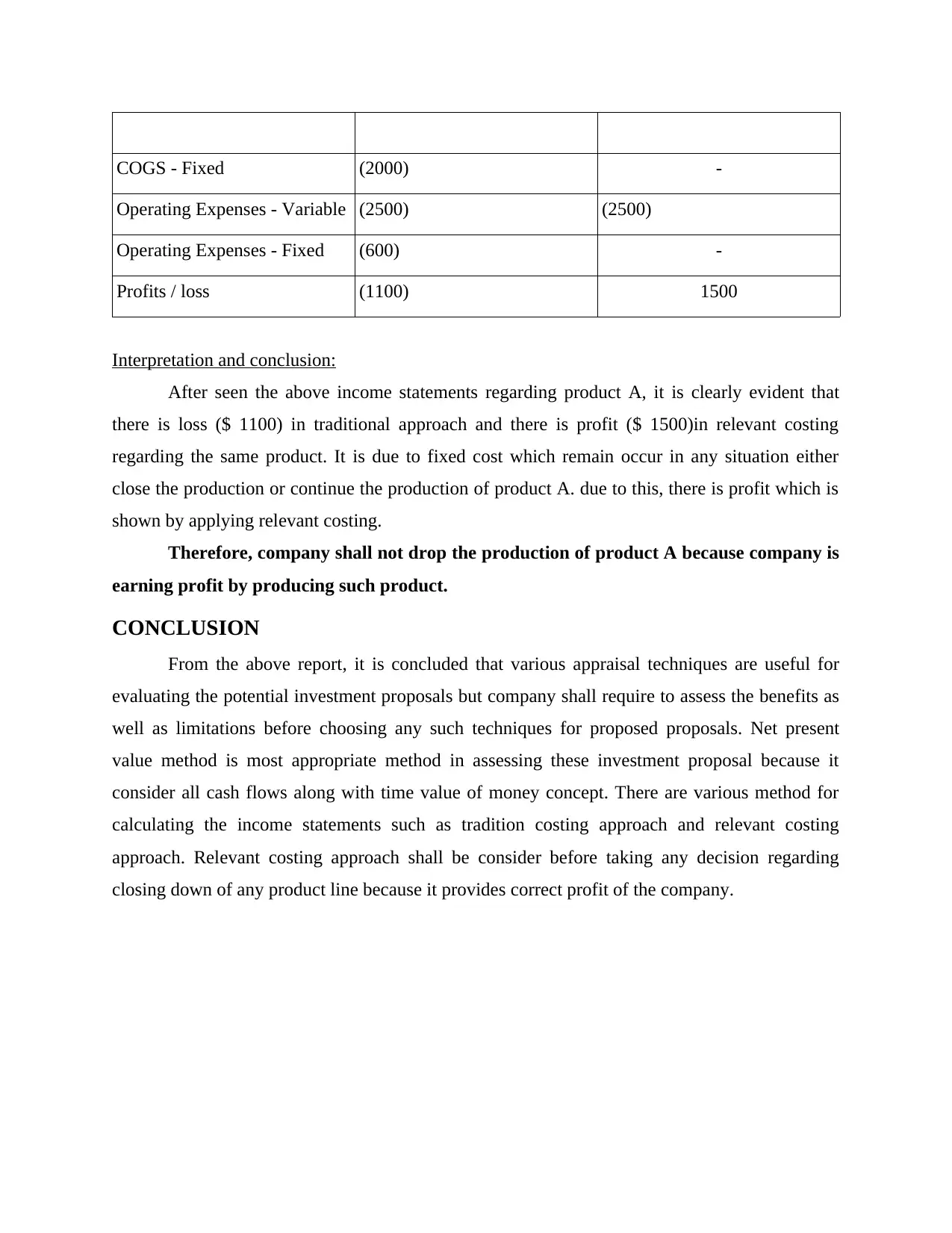
COGS - Fixed (2000) -
Operating Expenses - Variable (2500) (2500)
Operating Expenses - Fixed (600) -
Profits / loss (1100) 1500
Interpretation and conclusion:
After seen the above income statements regarding product A, it is clearly evident that
there is loss ($ 1100) in traditional approach and there is profit ($ 1500)in relevant costing
regarding the same product. It is due to fixed cost which remain occur in any situation either
close the production or continue the production of product A. due to this, there is profit which is
shown by applying relevant costing.
Therefore, company shall not drop the production of product A because company is
earning profit by producing such product.
CONCLUSION
From the above report, it is concluded that various appraisal techniques are useful for
evaluating the potential investment proposals but company shall require to assess the benefits as
well as limitations before choosing any such techniques for proposed proposals. Net present
value method is most appropriate method in assessing these investment proposal because it
consider all cash flows along with time value of money concept. There are various method for
calculating the income statements such as tradition costing approach and relevant costing
approach. Relevant costing approach shall be consider before taking any decision regarding
closing down of any product line because it provides correct profit of the company.
Operating Expenses - Variable (2500) (2500)
Operating Expenses - Fixed (600) -
Profits / loss (1100) 1500
Interpretation and conclusion:
After seen the above income statements regarding product A, it is clearly evident that
there is loss ($ 1100) in traditional approach and there is profit ($ 1500)in relevant costing
regarding the same product. It is due to fixed cost which remain occur in any situation either
close the production or continue the production of product A. due to this, there is profit which is
shown by applying relevant costing.
Therefore, company shall not drop the production of product A because company is
earning profit by producing such product.
CONCLUSION
From the above report, it is concluded that various appraisal techniques are useful for
evaluating the potential investment proposals but company shall require to assess the benefits as
well as limitations before choosing any such techniques for proposed proposals. Net present
value method is most appropriate method in assessing these investment proposal because it
consider all cash flows along with time value of money concept. There are various method for
calculating the income statements such as tradition costing approach and relevant costing
approach. Relevant costing approach shall be consider before taking any decision regarding
closing down of any product line because it provides correct profit of the company.
⊘ This is a preview!⊘
Do you want full access?
Subscribe today to unlock all pages.

Trusted by 1+ million students worldwide
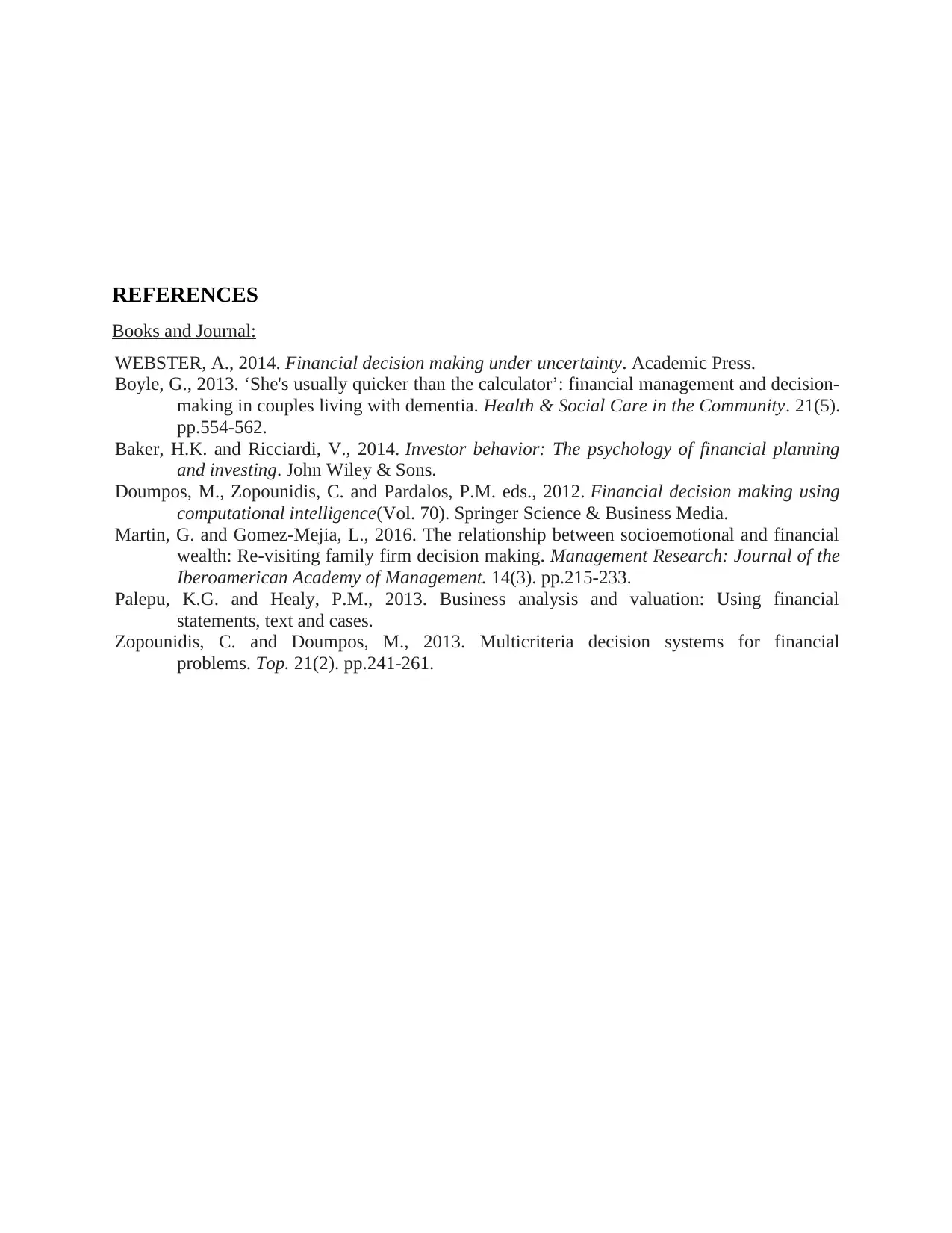
REFERENCES
Books and Journal:
WEBSTER, A., 2014. Financial decision making under uncertainty. Academic Press.
Boyle, G., 2013. ‘She's usually quicker than the calculator’: financial management and decision‐
making in couples living with dementia. Health & Social Care in the Community. 21(5).
pp.554-562.
Baker, H.K. and Ricciardi, V., 2014. Investor behavior: The psychology of financial planning
and investing. John Wiley & Sons.
Doumpos, M., Zopounidis, C. and Pardalos, P.M. eds., 2012. Financial decision making using
computational intelligence(Vol. 70). Springer Science & Business Media.
Martin, G. and Gomez-Mejia, L., 2016. The relationship between socioemotional and financial
wealth: Re-visiting family firm decision making. Management Research: Journal of the
Iberoamerican Academy of Management. 14(3). pp.215-233.
Palepu, K.G. and Healy, P.M., 2013. Business analysis and valuation: Using financial
statements, text and cases.
Zopounidis, C. and Doumpos, M., 2013. Multicriteria decision systems for financial
problems. Top. 21(2). pp.241-261.
Books and Journal:
WEBSTER, A., 2014. Financial decision making under uncertainty. Academic Press.
Boyle, G., 2013. ‘She's usually quicker than the calculator’: financial management and decision‐
making in couples living with dementia. Health & Social Care in the Community. 21(5).
pp.554-562.
Baker, H.K. and Ricciardi, V., 2014. Investor behavior: The psychology of financial planning
and investing. John Wiley & Sons.
Doumpos, M., Zopounidis, C. and Pardalos, P.M. eds., 2012. Financial decision making using
computational intelligence(Vol. 70). Springer Science & Business Media.
Martin, G. and Gomez-Mejia, L., 2016. The relationship between socioemotional and financial
wealth: Re-visiting family firm decision making. Management Research: Journal of the
Iberoamerican Academy of Management. 14(3). pp.215-233.
Palepu, K.G. and Healy, P.M., 2013. Business analysis and valuation: Using financial
statements, text and cases.
Zopounidis, C. and Doumpos, M., 2013. Multicriteria decision systems for financial
problems. Top. 21(2). pp.241-261.
1 out of 7
Related Documents
Your All-in-One AI-Powered Toolkit for Academic Success.
+13062052269
info@desklib.com
Available 24*7 on WhatsApp / Email
![[object Object]](/_next/static/media/star-bottom.7253800d.svg)
Unlock your academic potential
Copyright © 2020–2025 A2Z Services. All Rights Reserved. Developed and managed by ZUCOL.




